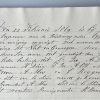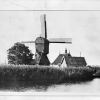The Schoonenberg, also spelled “Schonenberg” and “Schonenbergh”, was a trading ship operated by the VOC between 1717 and 1722. The ship, a Spiegelretourschip[1] or Dutch East Indiaman, was damaged beyond repair in an accident at Struisbaai, South Africa on 20 November 1722, during a return voyage to the Netherlands from Batavia, and was later burned and destroyed. This happened on the second of two calamitous voyages; on the maiden sailing in 1720, 75 of the crew died when the ship ran out of water and food on the leg from Cape Town to Ceylon, before finally reaching the diversion port of Mocha after spending 6 months stranded in present-day Somalia.
Under the command of Capt. Jan van der Linden, Schoonenberg left Texel on 10 February 1719 [1] on her maiden voyage with a final destination of Ceylon. Following the routine stop at Cape Town, the ship departed on 10 August 1719 for Ceylon with 221 crew on board. However, due to strong westerly winds the ship was unable to make progress to the east, and on 8 November, with dwindling supplies of water and food, the crew made the decision to divert to Mocha[2]. A navigational error meant that instead of entering the area of the Red Sea beyond Bab-el-Mandeb, the ship instead sailed into a river mouth at Saylac, Ajura (present day Zeila, Somalia). The river is referred to by the crew as the “Journaldus Rivier”, which is depicted on an old map of the VOC [3].
This mistake compounded their problems, because in addition to the lack of critical provisions, they faced a security problem: the hostility of the locals. On 25 November, they reached a point 8-9 miles upriver, and despite opposition from the third helmsman, Pieter Bellaard, the Captain ordered that they launch their small boat and go on shore to negotiate for supplies [2]. The attempt at bargaining ended in massacre: all but one of the 16 that went onshore were killed almost instantly by the locals, including van der Linden, the Captain.
Following the horrific murder of their compatriots, and with scores already dead from malnutrition, hunger, and thirst, the remaining crew were in a very difficult position, too weak to sail the ship elsewhere for help, and despondant to their fate. Thanks to a chance encounter on 28 November with a small local VOC ship, they were able to communicate their plight to the company post at Mocha. However, with limited resources, all the company could do was send occasional supplies to aid them, and the Schoonenberg remained where it was. On 8 December 1719, the crew tried to make sail for Mocha, but strong currents and a general air of despondancy prevented any progress [2]. No further attempts to sail were made until 25 March 1720, but again, they could not muster the strength to depart.
A final attempt in June of 1720 finally succeeded, and the Schoonenberg limped into the port of Mocha with 83 sailors, 59 soliders, 4 passengers, and a total of 75 dead [2]. In total, they had spent 6 months at the mouth of the river. The Schoonenberg finally reached Ceylon on 16 September 1720, and departed back to the Netherlands on 22 November, reaching Texel on 21 August 1721.
Notes
Source: DAS Schonenberg From 14-02 till 25-02-1719 at Duins, After departure from the Cape out of its course by storms, took refuge in the Red Sea, arrived finally at Mocha at the end of June 1720; the master and a few others were killed in Oba Bay, Ethiopia. [Location details incorrect in DAS, the events were in Zeila, Somalia] Source: VOC site (based on DAS, of course) Vanwege stormen zocht de Schonenberg beschutting in de Rode Zee. Het schip kwam eind juni 1720 in Mocca. Schipper Jan van der Linden en enkele anderen werden gedood in de Oba Bay in Ethiopië. [>] Source: Generale missiven van gouverneurs-generaal en raden aan heren XVII der Verenigde Oostindische Compagnie (Kaap) Tot onse bijsondere blijdschap oock op den 15" september buyten verwag- tinge het tot duslang vermiste schip Schoonenberg in compagnie der schepen Rotterdam en Lugtenburg aldaar was aangekomen uyt Mocha, werwaard hetselve, door verloop van 't mousson, gebreck aan provisiën en versch water, mitsgaders de sterfte onder het scheeps-volckende masacreaan nog 12 persoonen, in de rivier Journaldus (1) door de inwoonderen langs deselve geleden, geen kans siende om desselfs gedestineerde reyse na Ceylon te konnen voltrecken off de kust van Mallabaar te gewinnen, genoodsaakt was geweest na 't Roode Meir op te duwen. (l) Bedoeld zal wel zijn de Chor Nogal, een waterloop in Somaliland, uitmondend in de Indische Oceaan op ongeveer 8° N.B. [Location details again incorrect, the events were in Zeila, Somalia] Source: Precis of the Archives of Cape, Leibrandt [>] (1720) November 4 Arrival of the English ship Princess Anna from Mocha on the oth August and bound for England The captain reported that the Company's ship Schoonenberg which left the Cape for Ceylon on the 10th October 1719 had had the misfortune to pass Ceylon and the Malabar coast and been compelled to call at a haven named Sylla on the African coast near the Red Sea to get water It had already lost 100 men by death and still had many sick among them the chief and junior mates That the skipper putting too much faith in the good feeling of the natives had sent the junior merchant and 14 men on shore for water that all were massacred on landing and that only one escaped The third officer was consequently the sole surviving officer This was made known to the Company's office at Mocha which at once sent thither victuals men and officers The ship was then brought to Mocha whence it would leave for Ceylon He also stated that in the Gulf of Persia one ship belonging to the Company and three Moorish vessels had been captured by pirates. [Location details correct - Sylla = Zeila, though some details of the events are not accurate.] Crew Captain: Jan van der Linden (killed) Opperstuurman: Pieter Bellaard Bootsman: Cornelis Roos Constapel: Evert Decher [all from Ceylon journal Dec 1720 >] Ondercoopman: Jacobus Pompe van Meerdervoort Derde Waak: Evert de Clerq From the Ceylon VOC dagboek/journals above as to what happened [>] Departed the Cape 10 Aug 1719 with destination: _ 8 Nov 1719, made a resolution to divert to VOC Mocha due to lack of water and supplies, due to westerly winds. But it went wrong, and instead of sailing into the Red Sea, they sailed into a different place. 8 or 9 miles into the river Journaldus on the Abisinian coast. 14 crew includin Capt, Coopman, Bootsman went ashore. 3rd watch de Clerq had been onshore the day before, and warned the Captain on his return that the locals were hostile. Opperstuurman died on Apr 4 (1720) after illness, leaving Bellaerts the only survivor amongst the officers, and he became Captain. On 28 Nov they met an “inlands schip” who took a letter. On Dec 8th tried to leave to go to Mocha, but strong currents and weak crew. They ate from the leaves of a tree against scurvy. They then spent months there, getting occasional food via inland ships from Moccha. Tried again on March 25th. The crew were despondant. Finally arrived Mocha on June 23rd. Genealogy Jan van der Linden, son of Adam van der Linden, and father of unmarried daughter Catharina van der Linden, as per note in Soldijboek Schoonenberg [>]








